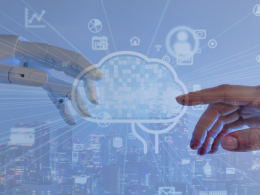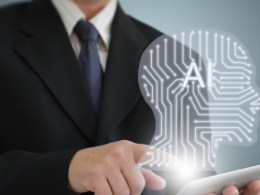![]() Here is an article by one of our Top 5 Budding Data Scientists, Prem Ranjan. Read how he discusses the applications of data science and AI in the healthcare industry. Prem is also ranked among Accredian’s Top Budding Data Scientist.
Here is an article by one of our Top 5 Budding Data Scientists, Prem Ranjan. Read how he discusses the applications of data science and AI in the healthcare industry. Prem is also ranked among Accredian’s Top Budding Data Scientist.
Artificial intelligence (AI) is the simulation of human intelligence processes by machines, especially computer systems.
These processes include learning, reasoning & self-correction. Artificial intelligence (AI) in healthcare is the use of complex algorithms and software to estimate human cognition in the analysis of complicated medical data.
At the core of the AI applications is data…
Data is the new oil, on which the engine of all businesses run. Data powers the information economy in the same way that oil-fueled the industrial economy.
– Data promises a plethora of new uses e.g. diagnosis of diseases, direction of traffic patterns, etc. – just as oil produced useful plastics, petrochemicals, lubricants, gasoline, and home heating.
– Data creates significant revenue flows for entirely new industries, just as oil did;
– Data is only valuable once it’s been processed (analytics). Similarly, oil is only valuable once extracted and processed.
Data now drives business decision-making.
The present challenge is to know, how to use that data to make the best business decisions possible. Being able to look at various pieces of data and draw a conclusion is probably the most valuable skill that any organization needs today.
In the world of healthcare, information is flowing faster than ever— and artificial intelligence (AI) will be needed to realize healthcare’s big data potential.
![]() The development of technology in healthcare has created enormous amounts of additional data without the ability to utilize and aggregate this data into useful information for providers.
The development of technology in healthcare has created enormous amounts of additional data without the ability to utilize and aggregate this data into useful information for providers.
A recent analyst report found that data related to healthcare was one of the fastest growing of any industry. It’s predicted that the total volume of medical information will rise from 153 exabytes in 2013 to 2,314 exabytes by 2020.
The bulk of that information is unstructured data.
Instead of being stored in spreadsheets and databases, it’s free-form digital notes and other documents. To create further challenges, some of these information is written comments scrawled on paper or physical images, like x-rays.
To extract any meaningful insights from this data, this data needs to be analyzed through the process of data exploration.
Based on the analysis, predictive algorithms need to be developed which would get evaluated against this data for stability & accuracy. These algorithms are the actual application of AI in any business domain.
Below are the steps that the data scientist usually follows:
– Prepping for Artificial Intelligence: Adding Structure to the Unstructured
– Taking it further: AI Mining Medical Data for Answers
– Using Artificial Intelligence & Data to develop appropriate AI-powered applications.
Healthcare organizations are actively embracing automated machine learning as the next evolutionary step for healthcare analytics, driving better outcomes, patient satisfaction, and operational efficiency.
Healthcare organizations are likely to see a rapidly growing market around artificial intelligence tools for medical imaging.
2.1 AI in Healthcare Information Technology
The biggest potential of AI in healthcare is towards improving patient outcomes and reducing costs.
Organizations are applying machine learning to make better and faster diagnoses than humans. One of the best-known healthcare technologies is IBM Watson. IBM Watson can understand natural language and provide answers to the user query. In the back-end, the system analyzes the patient data and other available data sources and develops hypothesis or responses which are rated on a confidence scoring schema.
Application of AI in augmenting diagnostics & decision-making is also increasing rapidly. Artificial intelligence has made especially swift progress in diagnostic specialties, including pathology.
Pathology is at the center of diagnoses, and diagnoses are at the heart of all patient care.
Healthcare organizations are increasingly eager to implement machine learning, deep learning, and other detailed pattern recognition algorithms that can provide clinical decision support while improving the efficiency of radiologists, pathologists, and other image-based diagnosticians.
Common AI applications include chatbots, a computer program used online to answer questions and assist customers, to help schedule follow-up appointments or aid patients through the billing process, and virtual health assistants that provide basic medical feedback.
![]() Traditionally, this used to be a labor-intensive job. With the advent of Chatbots in healthcare, overnight the industry became capable of serving patients with important FAQ’s, the ability to schedule appointments with doctors, managing prescription issues and even making payments to medical centres.
Traditionally, this used to be a labor-intensive job. With the advent of Chatbots in healthcare, overnight the industry became capable of serving patients with important FAQ’s, the ability to schedule appointments with doctors, managing prescription issues and even making payments to medical centres.
It freed up more quality time for doctors and patients, as much of the reassuring element of medical care is now AI-assisted. For doctors, the chatbots came as a boon, which could serve physicians with a streamlined support service to manage referrals, track the critical care process and help reduce human error.
AI also streamlines the security & accessibility of patient data.
According to a survey, a doctor in the US attends 18 patients a day on an average. This means, in a year he sees 2,160 patients. A hospital with a staff of 20 doctors will have 360 patients on a daily visit.
Today, doctors are using AI to manage the data of thousands of these patients and keeping them secure and confidential without restricting the concerned doctor from accessing. The healthcare delivery to the consumers is highly dynamic. Therefore, it often becomes hard to keep track and predict the future of the healthcare system.
Healthcare providers are increasingly identifying ways to improve healthcare access and are prioritizing consumer experience to cope with changing patient needs.
![]() According to the World Health Organization, 60% of related factors to individual health and quality of life are correlated to lifestyle choices, including taking prescriptions such as blood-pressure medications correctly, getting exercise, and reducing stress.
According to the World Health Organization, 60% of related factors to individual health and quality of life are correlated to lifestyle choices, including taking prescriptions such as blood-pressure medications correctly, getting exercise, and reducing stress.
Aided by AI-driven models, it is now possible to provide patients with interventions and reminders throughout this day-to-day process based on changes to the patient’s vital signs.
Another application of AI is the home health monitoring.
The concept itself isn’t new.
Active programs and pilot studies are underway through leading institutions ranging from Partners Healthcare, United Healthcare, and the Johns Hopkins School of Medicine, with positive results.
Because of the massive volumes of data involved, machine learning algorithms are particularly well-suited to scaling that task for large populations. After all, large sets of data are what power AI by making those algorithms smarter.
Application of artificial intelligence (AI) in radiology is another rapidly growing field. Artificial intelligence has the potential to transform the medical imaging field. From detecting lung cancer as well as human radiologists to predicting kidney function from renal biopsies, machine learning and deep learning algorithms have demonstrated their potential to improve imaging diagnostics and patient care.
Below are some of the key application of AI in the field of Radiology,
• Improve Image Acquisition
While a lot of attention is being paid to interpreting images, artificial intelligence can also be used to improve their acquisition. Philips Healthcare highlighted a second technology called VitalEye that can automatically adjust scanning parameters for patient positioning.
Similarly, Imalogix demonstrated how its AI algorithms can ensure that computed tomography (CT) scans are aligned properly to minimize the radiation dose exposure to the patient.
• Algorithms to Improve Detection
Another popular use of AI is improving detection of various conditions in a radiological image. iCAD displayed a new AI-fueled software, ProFound AI, designed to improve the detection of breast cancer in a mammogram. Each detected lesion is assigned a score from 0-100 representing the algorithm’s confidence in the lesion’s malignancy.
The score is based on the volumes of data used to train the algorithm.
Application of AI in Dentistry is also showing tremendous scope and is a rapidly changing field. From analyzing X- rays to documenting the results of your visit, artificial intelligence will be relied upon to make your dental appointment more efficient and to enhance your care.
• Dental Examination & Imaging
Dentem created a platform that integrates machine learning APIs, including the ability to auto-populate tooth charting. It offers dental practices software services that synchronize appointments across all platforms and maintains all patients’ records electronically.
They currently offer Dx Vision that uses machine learning to assess dental images for areas of concern and soon will offer D Assistant, a virtual assistant that will respond to a dentist’s voice commands.
• Changing Dental Insurance with Technology
Beam, a dental PPO insurance provider for small- and medium-sized companies, promises smarter dental care. Members of Beam receive all they need to take care of their teeth including a Beam Brush, toothpaste, refill heads and floss delivered to their doorstep with free shipping every six months.
The brush records the time and frequency of the person’s brushing and then syncs that data with the company’s app. This data is used to determine premiums for dental insurance, so the better people brush, the lower the cost for the insurance. This new approach to dental care is touted as “the most innovative thing to happen to the dental insurance market, ever.”
• Millennial Makeover
Since millennials (18- to 35-year-olds) are becoming a significant segment of the economy, companies are trying to adapt products and services to appeal to them.
New dental products such as the Quip toothbrush and services and technological enhancements are designed and marketed in part to get millennials to take care of their teeth. The Quip toothbrush was developed in collaboration with dentists to create an affordable electric toothbrush to help simplify better brushing.
AI is also being applied in the below areas to reduce effort, costs & errors and provide higher patient satisfaction,
• Workflow & Task Automation
AI can help automate routine, high-volume tasks, prioritize and triage cases to ensure patients are getting speedy access to the right care, and make sure that pathologists don’t miss key information hidden in the enormous volumes of clinical and test data they must comb through every day.
AI has the potential to make the practice of medicine faster by automating routine and time-consuming practices. The quickening of the diagnostic process could shorten the time to treatment.
Automating some of the routine tasks that take up a physician’s time, such as EHR documentation, administrative reporting, or even triaging CT scans, can free up humans to focus on the complicated challenges of patients with rare or serious conditions.
Most the major EHR vendors have embraced artificial intelligence as a transformative technology that will rewrite workflows, simplify interactions with complex data, and give providers back the time they need to do much more of what they love.
Making payments, scheduling appointments, conducting follow-up visits, or even waiting for a nurse to answer the phone to triage a low-level complaint all create friction in the patient-provider relationship.
• AI has the potential to combine with FHIR
AI has the potential to combine with Fast Healthcare Interoperability Resources technology, to unlock siloes of health data and support broader access to health information.
Patients, providers, and researchers will all benefit from a more fluid health information exchange environment, especially since artificial intelligence models are extremely data-hungry.
• Application of AI in risk scoring for chronic diseases & population health
AI helps organizations to identify individuals with elevated risks of developing chronic conditions as early in the disease’s progression as possible have the best chance of helping patients avoid long-term health problems that are costly and difficult to treat.
Creating risk scores based on lab testing, biometric data, claims data, patient-generated health data, and the social determinants of health can give healthcare providers insight into which individuals might benefit from enhanced services or wellness activities. e.g. Health Insurance giants, Anthem is using its data analytics tools to create consumer profiles that allow the payer to send tailored messaging, improve customer retention, and discover what strategies are most likely to be impactful for everyone.
Providers, too, are using behavioral patterns to create meaningful care plans and keep patients engaged with their financial and clinical responsibilities.
• Application of AI in predicting doctor appointment no-shows
Patient no-shows are associated with substantial reimbursement losses and can create significant administrative and workflow burdens. Using information from the EHR, organizations can create predictive models to determine the likelihood that a patient will experience a certain outcome, including patient no-shows and late cancellations.
![]() Using predictive analytics to identify patients likely to skip an appointment without advanced notice can improve provider satisfaction, cut down on revenue losses, and give organizations the opportunity to offer open slots to other patients, thereby increasing speedy access to care.
Using predictive analytics to identify patients likely to skip an appointment without advanced notice can improve provider satisfaction, cut down on revenue losses, and give organizations the opportunity to offer open slots to other patients, thereby increasing speedy access to care.
According to a study from Duke University, EHR data can reveal individuals who are most likely to no-show. A team found that predictive models using clinic-level data could capture an additional 4800 patient no-shows per year with higher accuracy than previous attempts to forecast patient patterns.
• Application of AI in predicting patient utilization patterns
In addition to helping organizations get ahead of no-shows, predictive analytics can give providers a heads up when the clinic is about to get busy. Care sites that operate without fixed schedules, such as emergency departments and urgent care centers, must vary their staffing levels to account for fluctuations in patient flow.
Inpatient wards must have beds available for patients who need to be admitted, while outpatient clinics and physician offices are responsible for keeping wait times low for patients. Using analytics to predict patterns in utilization can help to ensure optimal staffing levels while reducing wait times and raising patient satisfaction.
Machine learning is critical for assessing all the claims information that comes into insurance providers to identify patterns and potential fraud. This is also how patient data can be used by algorithms to see and learn critical information from the aggregate data that can ultimately inform care decisions.
• Application of AI in improving patient engagement & satisfaction
In addition to supporting chronic disease management strategies, cutting wait times, and targeting therapies to produce better outcomes, predictive analytics can keep patients engaged in other aspects of their care, as well.
Consumer relationship management has become a vital skill for both providers and insurance companies looking to promote wellness and reduce long-term spending – and predicting patient behaviors is a key component of developing effective communications and adherence techniques.
3.1 Conclusion
With the help of these AI applications, there will be a reduction in human errors eventually improving the results. AI and wearables are two cutting-edge technologies that are disrupting many industries. Healthcare is an industry that can gain a vast array of benefits by both AI as well as the wearable technologies.
The use of AI is predicted to decrease medical costs as there will be more accuracy in diagnoses and better predictions in the treatment plan as well as more prevention of disease.
Leveraging AI for clinical decision support, risk scoring, and early alerting is one of the most promising areas of development for this revolutionary approach to data analysis.
The US is facing a dangerous physician shortage, especially in rural regions, and the drought is even worse in developing countries around the world. As of 2016, the healthcare industry lacked 20,000 primary care physicians, according to statistics from the Association of American Medical Colleges (AAMC), and the deficit is only projected to grow.
By 2030, the industry could be short up to 120,000 primary care physicians by 2030, AAMC said in revised estimates for 2018.
![]() Proper application of AI in healthcare will help the physicians struggling to meet the demands of the increasing number of patients. AI may also help to alleviate the stresses of burnout that are driving physicians out of practice.
Proper application of AI in healthcare will help the physicians struggling to meet the demands of the increasing number of patients. AI may also help to alleviate the stresses of burnout that are driving physicians out of practice.
The epidemic affects most physicians, not to mention nurses and other care providers, who are likely to cut their hours or take early retirements rather than continue powering through paperwork that leaves them unfulfilled.
Artificial Intelligence has tremendous potential to bring efficiency in the Healthcare domain and would continue to impact the industry. Below are some of those areas:
• Assisted Surgery
• Virtual Nurses
• Admin Workflow Simplification
• Fraud & Abuse Detection
• Dosage Optimization
• Connected Machines & IoT
• Clinical Research & Trials
• Diagnoses
• Radiology & Image review
• Cybersecurity
Although, AI presents a whole new set of challenges around data privacy and security. Security and privacy will always be paramount, but this ongoing shift in perspective as stakeholders get more familiar with the challenges and opportunities of data sharing is vital for allowing AI to flourish in a health IT ecosystem where data is siloed and access to quality information is one of the industry’s biggest obstacles.
Application of AI offers advantages over traditional analytics and clinical decision-making techniques. Algorithms learns as it gets exposed to newer data and becomes more stable & accurate over time, allowing humans to gain critical insights into patient diagnoses, care management treatment variability, and patient outcomes.
AI can aggregate and analyze huge volumes of data from different data sources and yield insights and diagnoses for a broader segment of the population, in significantly lesser time. As the AI domain continues to evolve, the potential towards improving patient outcomes and reducing costs is tremendous and the application AI in Healthcare will continue to increase.
This ends Prem’s article… On behalf of Accredian, we wish him good luck!






Informational post! especially workflow automation
Insightful article! apart from data accuracy, algorithm detection, workflow test automation, AI can help with the documentation process also. I would like to suggest an application called Cliibot AI which helps automate your documentation process and reduces physicians workflow